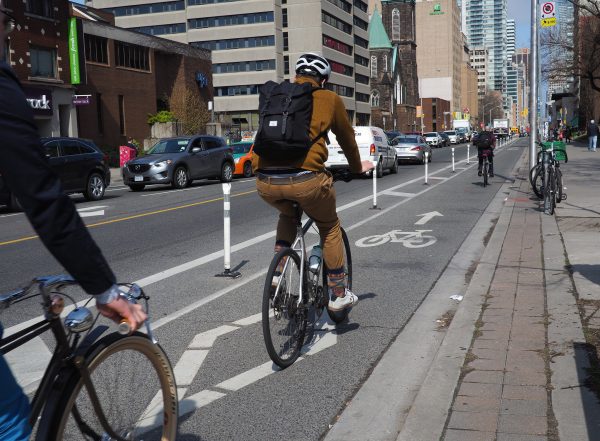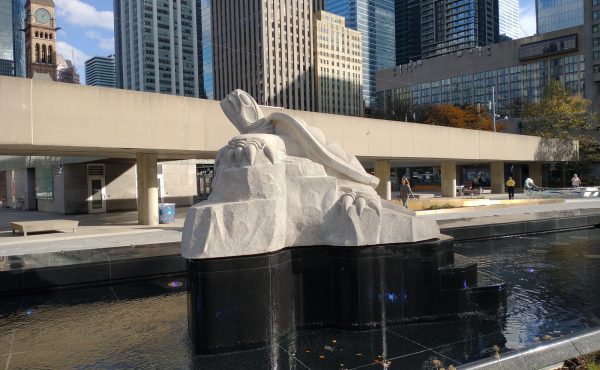Ontario superior court justice Paul Schabas this week granted an interim (“interlocutory”) injunction preventing Queen’s Park from ripping up three Toronto bike lanes pending a final decision, and the ruling reads like a vindication for the city’s cycling community.
Justice Schabas found that the province had failed to make any kind of persuasive argument that removing bike lanes from Bloor-Danforth, Yonge and University would improve congestion. Picking up on internal government documents obtained by Cycle Toronto, he also noted that Queen’s Park had done precious little in the way of planning to ensure this ridiculous project would protect cyclists or prevent even more congestion.
Finally, Justice Schabas largely agreed with Cycle Toronto’s lawyers that there’s good reason to believe that removing the lanes would expose cyclists to significant personal risk, potentially violating their Section 7 Charter right to “life, liberty and security of the person.”
A final ruling is expected several months hence. Justice Schabas could make the injunction permanent, which would mark a huge victory over a politicized pre-election stunt by the Ford government. It seems the decision could be appealed one way or the other.
The legal wrinkle, of course, is the familiar stick in the spokes: that under Canada’s Constitution, provinces have more or less complete jurisdiction over municipalities. As the government’s lawyer put it, what the province giveth, the province can taketh away.
Still, this quote-unquote project is on hold for now, and there’s a lot of legal process yet to come, which, in a sane world, offers the Ford government an off-ramp.
Canada’s division of powers allows provincial governments to do almost anything to municipalities. Queen’s Park theoretically could disband the whole lot of them in order to impose draconian solutions to congestion…but it won’t because maximalist expressions of its legal powers make no sense, politically or administratively. Indeed, a hallmark of responsible government in Canada is knowing how to stay in your jurisdictional lane.
Ford and his attorney general, in short, will soon have a choice to make. When Justice Schabas’ final ruling comes out, they could barrel ahead, or order their lawyers to stand down and allow the negotiations said to be taking place with the City to play out. There’s nothing inevitable about what’s happening or what might happen, notwithstanding the constitutional reality that Queen’s Park holds most of the cards.
The outcome depends, to some extent, on which premier shows up to make the call: the Dr. Jekyll version, who has shown himself to be both a team player and compelling spokesperson in Canada’s surreal trade/sovereignty war with Donald Trump; or the Mr. Hyde monster, whose terms have been punctuated by partisan stunts, insider shenanigans, and multi-billion-dollar boondoggles. One day Ford backs the continuation of the federal Liberals’ $10/day daycare program but the next he’s shilling for the 401 tunnel that will never ever get built.
Sometimes the shape-shifting even occurs within a single news cycle, almost a Jekyll and Hyde routine. Case in point: just hours after last week’s New York Times bombshell, which revealed that Therme had grossly misrepresented itself when bidding to redevelop the West Island, Ford promised to review the notorious 95-year lease and the process that led to it (Dr. Jekyll). By the next day, he’d declared that the whole stinky deal was just fine (Mr. Hyde).
Bringing this duality back to the subject of congestion, it’s worth noting that the Ford government’s only effort to sort out Toronto’s traffic mess has been the bike lane law. By contrast, council yesterday thoroughly canvassed the matter of getting a better grip on congestion, approving a number of measures to mitigate tie-ups near the Gardiner, clamp down on illegal parking and limit developers’ ability to block lanes for years during construction. Council even approved the creation of a traffic czar, which smells a bit like window-dressing, but nonetheless signals the city’s determination to confront this multi-headed hydra.
Despite its rhetorical commitment to get traffic moving in Toronto, the Ford government did none of this, apparently because it still has some faith in the municipality to confront these issues using the range of the tools that are within its remit. Nor would Queen’s Park ever dare to question whether the delays created by its big transit projects or normal-course road-reconstruction — Toronto has two seasons, etc. — be paused so as not to inconvenience SUVs from Etobicoke.
Here’s the point: With a provincial election in the rear-view mirror, a majority government in hand, and Ford’s own attention seemingly trained on the void that will be left atop the Conservative Party if Pierre Poilievre goes down in flames on Monday, the case for pressing ahead with an ill-conceived pre-election wedge tactic could scarcely be weaker — especially in the face of a legal decision that is clearly tacking in the opposite direction.
The superior court this week gave Ford & Co. a rare opening to send the whole idea into the maw of endless studies and consultation, and eventually oblivion. To get there, however, the premier now needs to get his head back to Dr. Jekyll mode and be the political adult that he’s shown himself to be occasionally capable of being. No one wants Mr. Hyde charging up and down Toronto streets, ranting about traffic. There are better and safer ways to confront congestion without sacrificing the bodies of people travelling on two wheels.






2 comments
Also worth noting that the plan backfired as an election stunt, with Christine Hogarth losing her seat in Etobicoke-Lakeshore
Rob Ford said that “Streets are for the automobile”. Wrong! Streets are for people. That includes pedestrians and cyclists. Transportation is not just the automobile, but include pedestrians, cyclists, and public transit users.